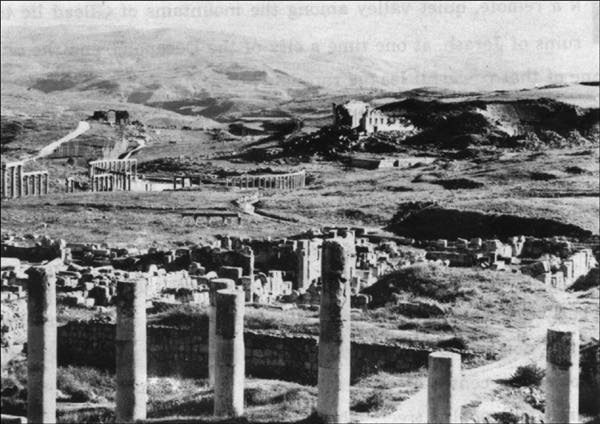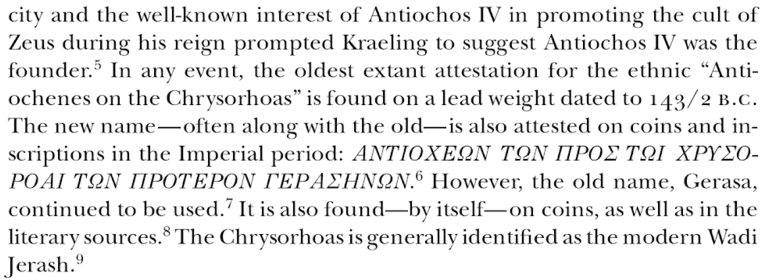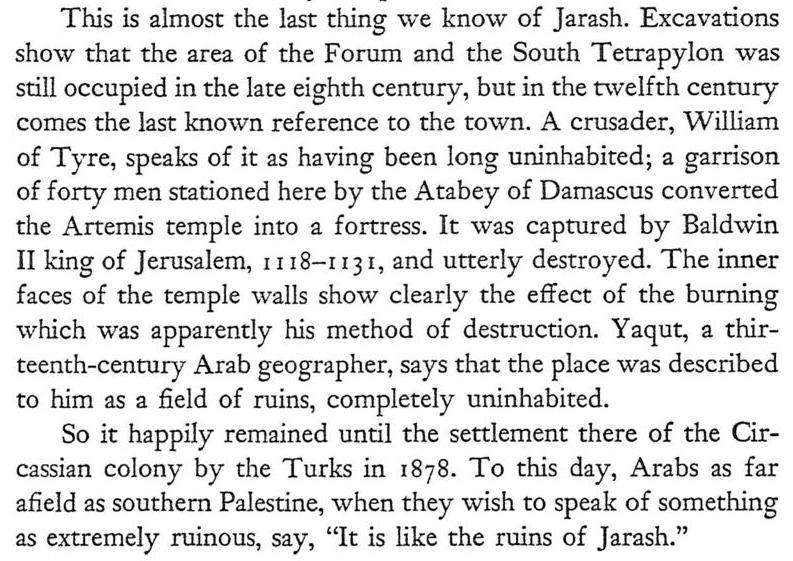|
Other Archaeological Sites / The Neolithic of the Levant (500 Page Book Online) Roman Gerăsa (Arabic Jerash: جرش -- Ancient Greek: Γέρασα) in Jordan
Read: Jerash by James Blake Wiener --- Ancient History Encyclopedia (2009-2019)
The Ruins of Gerasa in 1816-1819: An Analysis of the Plan and Drawing Archives
Gerasa in the Perseus Digital Library (Tufts University)
Updated June 28th 2019 The history of the city is a blend of the Greco-Roman world of the Mediterranean Basin and the ancient traditions of the Arab Orient.[2] The name of the city reflects this interaction. The earliest Arab/Semitic inhabitants, who lived in the area during the pre-classical period of the 1st millennium BCE, named their village Garshu. The Romans later Hellenized the former name of Garshu into Gerasa. Later the name transformed into the Arabic Jerash.[3][2]) (WikiPedia) ... (1) Gerasa (Jerash) Jordan in the The Princeton Encyclopedia of Classical Sites (1976) About 48 km N of Amman/Philadelphia in the hills of Gilead S of the Hauran. It was transformed from a village into a considerable town in Hellenistic times, perhaps by Antiochos IV Epiphanes (175-164 B.C.) and was known then as Antioch on the Chrysorhoas. Early in the 1st century B.C. it was annexed by Alexander Janneus to Jewish territory and in 63 B.C. Pompey in his reorganization of the East assigned it to Roman Syria as one of the towns of the Decapolis; in the 3d century A.D. it was elevated to the rank of colony. As a provincial agricultural, mining and caravan town Gerasa flourished under the Roman Empire, remaining relatively prosperous until in the 7th century it was captured first by the Persians (614) and then by the Arabs (635). One of the few ancient writers to mention Gerasa is Josephus (Wars of the Jews 1.104); however several hundred inscriptions, chiefly of Imperial date, have been found on the site. Considerable excavation and restoration has taken place since 1920.
(3) The Earliest History of Jerash by Nelson Glueck in Bulletin of the Possessed of abundant natural advantages, the site of Gerasa, situated in the midst of fertile farm lands in which strong and steady springs flow, and close to an extensive forest region where one can still ride for hours in leafy shade, would seem to have been occupied from the earliest historical times on. Carl Kraeling assumes that “the site was occupied at an early date and was in all probability no more than a small village of shepherds and tillers of the soil". Discoveries made very recently in the Jerash region give basis in fact to this assumption while at the same time showing why the earliest settlement was not found within the limits of Gerasa proper. The inhabitants of Transjordan during the period in question were apparently predominantly an agricultural people. Good water, fertile soil and an easily defended hill-top were evidently an ideal combination for them. It is obvious too from repeated examples of this combination that Bronze Age farmers also cultivated the tops of the hills which they enclosed within a strong outer wall. Their houses were situated in part of the enclosed area but a large part of it was devoted to cultivation. That is also why, in the majority of instances, the remains of only a few houses have been found in these hill-top areas. Today also this Jerash hill-top is cultivated. Following the pattern of their contemporaries the Early Bronze settlers of Jerash fortified the flattish hill-top immediately overlooking the very strong spring at the foot of the hill which the builders of Gerasa walled in so beautifully and which is still used today by the population of the Circassian village of Jerash ... The Bronze Age settlers always chose the more easily defendable and at the same time the more healthy location on top of a hill below which there was a strong spring, rather than the water-soaked malaria-ridden location at its foot.
(4) The Land and the Book: Biblical Illustrations Drawn from the Manners and Customs "We have now reached the regular road from el Husn to Souf and Jerash and will have the shade of this noble forest of oak, pine and other trees for the rest of our ride ... There is not a breath of air in these thick woods and the heat is most oppressive both to ourselves and our weary animals"
"I finally convinced him that we were able to take care of ourselves and could dispense with his services as protector and guide ... Canon Tristram and his party were insulted, threatened and nearly robbed here. They were compelled to pay an exorbitant sum before they were allowed to leave and had to abandon all idea of visiting Jerash. Subsequently however under the protection of the Adwan Arabs, they were more successful and Sheikh Abd el Aziz, with a strong party, recovered the money, levied as a fine the sheikh's best cow and brought him and his friends under compulsion to be their guards to Pella, whither the Adwan could not accompany them. The village has not improved in any respect during the last fifty years and there are no remains of antiquity about it with the exception of a ruined square building, a few broken columns and one or two Greek inscriptions almost illegible. Let us now start for Jerash, where we shall spend a day of unusual interest amongst the wonderful ruins of that once splendid city. The site is about four miles to the south-east of Souf and the road to it winds along the west bank of this stream in Wady ed Deir and around the heads of shallow valleys amongst olive-trees and through straggling woods of pine, oak and evergreen bushes for nearly an hour to Muzar Abu Bekr, a Moslem saint's tomb. These people coming out to the road to meet us are some of the temporary occupants of the Muzar and they offer a few old coins for sale but none of them are of any special value. From Abu Bekr there is a long and steep descent of about a mile to the north wall of the city. On the left of the road and not far from the city wall are many sarcophagi—upwards of fifty—scattered, as you see, far and wide over the hill-side. The inscriptions upon them and the sculptured festoons and genii in bass-relief have been nearly obliterated and defaced; but careful search and excavation might bring to light some interesting relics of a bygone age for that must have been the cemetery of ancient Gerasa. We have now entered Jerash through this breach in the wall near the north-west corner and from here we can take a general survey of this once beautiful city: groups of columns standing around the fallen walls of ancient temples; shapeless ruins of private dwellings and massive remains of great theatres; the main street, with a long double colonnade, terminating at the southern end in the forum with its grand circle of a hundred columns or more; the triumphal arch near the entrance to the town from the south and the crumbling walls of the city with their ruined towers and shattered battlements——these are some of the principal features which strike the beholder as he gazes upon this wonderful picture of ruin and desolation. But the little stream called Seil Jerash, that winds through the town with its foaming rapids and rocky banks fringed with green oleanders in full bloom, imparts life and beauty to the scene and relieves the dreariness of this deserted city"
Jerash was an abandoned town when the Circassians chose to settle in its area in the second half of the 19th century. The plenitude of water, abundance of wooded areas and the surrounding hills were all physical characteristics of the environs of Jerash which are reminiscent of the geography of Circassia. The boundary of the new village was defined by the Roman Wall to the east of the main ruins. A rough estimate is that between one thousand and two thousand Circassians found a new home in Jerash in the period 1878-1879 (6).
(1) GERASA (Jerash) Jordan in the The Princeton encyclopedia of classical sites (1976)
(2) The Hellenistic Settlements in Europe, the Islands, and Asia Minor by Getzel Cohen (1995)
(3) The Earliest History of Jerash by Nelson Glueck in Bulletin of the
(4) The Land and the Book: Biblical Illustrations Drawn from the Manners and Customs
(5) The Antiquities Of Jordan by Gerald Lankester Harding -- Pages 63-89 (1959)
(6) The Circassians in Jerash (Circassian Voices)
Jerash by James Blake Wiener --- Ancient History Encyclopedia (2009-2019)
The Danish-German
Jerash Northwest Quarter Project at Aarhus University in Denmark |







